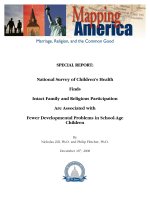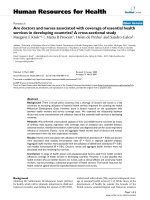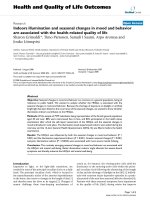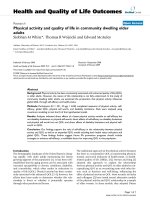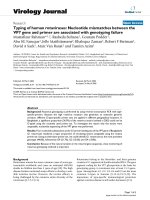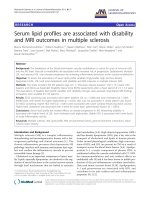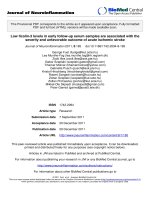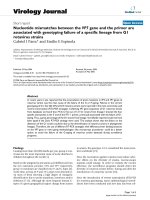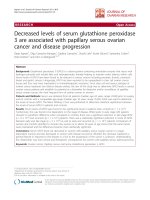Sleep duration and excessive daytime sleepiness are associated with incidence of disability in community dwelling older adults
Bạn đang xem bản rút gọn của tài liệu. Xem và tải ngay bản đầy đủ của tài liệu tại đây (1.09 MB, 24 trang )
Kobe University Repository : Thesis
学位論文題目
Title
Sleep duration and excessive daytime sleepiness are associated with
incidence of disability in community-dwelling older adults.(地域在住高齢
者において、睡眠時間と過度の日中の眠気は障害発生に関連する)
氏名
Author
中窪, 翔
専攻分野
Degree
博士(保健学)
学位授与の日付
Date of Degree
2017-03-25
公開日
Date of Publication
2018-03-01
資源タイプ
Resource Type
Thesis or Dissertation / 学位論文
報告番号
Report Number
甲第6908号
権利
Rights
JaLCDOI
URL
/>
※当コンテンツは神戸大学の学術成果です。無断複製・不正使用等を禁じます。著作権法で認められている範囲内で、適切にご利用ください。
Create Date: 2018-09-19
博
士
論
文
Sleep duration and excessive daytime sleepiness are associated
with incidence of disability in community-dwelling older adults.
(地域在住高齢者において、
睡眠時間と過度の日中の眠気は障害発生に関連する)
平成 29 年 1 月 20 日提出
神戸大学大学院保健学研究科保健学専攻
中窪
翔
INTRODUCTION
Disability in older adults, which is a growing public health concern, is associated with
poorer physical and mental health, greater use of medical care, and a higher rate of
institutionalization
1, 2
. Identifying risk factors for incident disability is therefore important for the
development of preventive strategies.
Sleep disturbances are common among older adults, with over half of community-dwelling
older adults reporting chronic sleep complaints 3. Sleep complaints have been associated with various
adverse health outcomes, including disability in older adults 4. Previous studies have identified insulin
resistance 5, autonomic nervous system dysregulation 5, 6, metabolic derangement 7, and inflammation
8
as potential mediators between sleep disturbances and incident disability. Only one longitudinal
study has examined the association between sleep complaints and incident disability among older
adults.4 Change in sleep duration with aging is common, and a longitudinal study has revealed that
long sleepers tend to have relatively poorer sleep quality.9 However, the association between sleep
duration and incident disability has not yet been fully elucidated.
In contrast, many studies have investigated excessive daytime sleepiness (EDS) in older
adults. EDS is one of the most common sleep disturbances, and presents in 15% to 30% of
community-dwelling older adults
10-12.
EDS is associated with several adverse health outcomes,
including psychiatric disorders 13, falls 14, and cognitive deficits 15, 16. Although a few cross-sectional
1
studies have shown an association between disability and sleep complaints, such as difficulty falling
asleep or awakening during the night or early morning
4, 17
, the impact of EDS on the risk of
disability is not well understood. Thus, additional evidence is needed to reveal these associations.
No longitudinal study has examined the impact of both sleep quality and quantity on
incident disability. In the current study, we examined whether EDS, sleep duration, and their
combination affect subsequent incident disability in community-dwelling older adults. We
hypothesized that those who have both long sleep durations and EDS would reflect the worsened
sleep conditions and show more risk of disability than those with either EDS or long sleep durations
only.
2
MATERIALS AND METHODS
Setting and participants
The Obu Study of Health Promotion for the Elderly (OSHPE) is an observational study
designed to investigate physical and cognitive function among the elderly population. The study
enrolled 5,104 community-dwelling older adults. Participants were recruited from Obu, Japan, which
is a residential suburb of Nagoya. Inclusion criteria required that participants were aged 65 years or
older at examination in 2011 or 2012, lived in Obu, and had not participated in another study in the
past. After the baseline assessment, monthly information on participants’ health status, including
incident disability as assessed by the Japanese public long-term care insurance (LTCI) system, death,
or relocation from Obu was obtained from the Obu city office. Three hundred and forty-eight
participants were excluded based on the following criteria: 1) missing values at baseline assessment;
2) a history of Parkinson’s disease, Alzheimer’s disease, or depression; 3) severe cognitive
impairment as indicated by Mini Mental State Examination (MMSE) scores < 18 18; and 4) already
certified by LTCI at any level during the baseline assessment. The final analysis sample consisted of
4,755 participants. Informed consent was obtained from all participants before their inclusion in the
study, and the Ethics Committee of the National Center for Gerontology and Geriatrics approved the
study protocol.
3
Measures
Certification of need for care in the LTCI system
The nationally uniform criteria for long-term care need certification was objectively
established by the Japanese government, and certification of need with respect to levels of care for
older adults is determined based on evaluation results by the Certification Committee for Long-Term
Care Need in municipalities in accordance with these basic guidelines. The process of eligibility for
certification of need for care in the LTCI system is as follows: (1) an elderly person or caregiver
contacts the municipal government to request official certification of the care needs of the applicant;
(2) a trained local government official then visits the home to evaluate nursing care needs based on
current physical and mental status; (3) after completion of the assessment, the results are entered into
a computer to calculate the standardized scores on physical and mental status, estimate the time
required for the care of the individual (grooming, bathing, eating, toileting, transferring, assistance
with instrumental activities of daily living (IADL), behavioral problems, and rehabilitation and
medical services), and assign a care-need level based on the total estimated care time; (4) the care
needs certification board reviews the data, which include a report from the primary physician of the
applicant; and (5) finally, the applicant is assigned to the level of care required (certified
support-level ranging from 1–2 or care-level ranging from 1–5). Every 6 months, the eligibility of
4
the individual receiving care via the LTCI system is re-evaluated. In the present study, incident
disability was defined as the onset of certification at support-level 1–2 or care-level 1–5.
Assessment of sleep habits
At baseline assessment, participants were asked about usual sleep and wake times, and the
answers were used to calculate sleep durations. EDS was assessed using the question “How often do
you have daytime sleepiness requiring a nap?” with the following options: “almost always,”
“sometimes,” and “rarely or never.” EDS was deemed to be present when it was reported to occur
“almost always.”
Other measurements
Sociodemographic variables including sex, age, and education level (years) were collected
along with medical history, weight (kg), and height (m). Body mass index (BMI) was derived as
weight in kilograms divided by the square of height in meters. Participants were asked about medical
diagnoses and medications via face-to-face interviews. Depressive symptoms were measured with
the Geriatric Depression Scale
19
(range 0–15), with higher scores indicating more depressive
symptoms. The Geriatric Depression Scale includes 15 items, and participants whose total score was
≥6 were defined as having depressive symptoms. Global cognitive function was measured using the
5
MMSE. Physical activity was assessed by the total amount of time spent walking on an average day.
For smoking and alcohol drinking status, participants were categorized as current, past, or never
smokers or alcohol drinkers, respectively.
Statistical Analysis
All analyses were performed using SPSS 21.0 J for Windows (SPSS Japan Inc., Tokyo,
Japan). Participants were divided into three groups according to sleep duration (short: ≤6.0 h, mid:
6.1 to 8.9 h, long: ≥9.0 h)20-22 and categorized with respect to presence or absence of EDS.
Furthermore, we also divided participants according to the combination of sleep duration and EDS
as follows: 1) short sleep duration and absence of EDS (short & no EDS); 2) short sleep duration and
presence of EDS (short & EDS); 3) mid sleep duration and absence of EDS (mid & no EDS,
control); 4) mid sleep duration and presence of EDS (mid & EDS); 5) long sleep duration and
absence of EDS (long & no EDS); and 6) long sleep duration and presence of EDS (long & EDS).
Continuous data are presented as means ± standard deviations (SDs). Characteristics were
summarized as means ± SDs for continuous variables and as counts and percentages for categorical
variables. Comparisons were performed using analysis of variance and Pearson’s chi-square test for
categorical data. Kaplan-Meier survival analysis for the incidence of disability was performed to
compare sleep duration or presence of EDS. Furthermore, univariate and multivariate Cox’s
6
proportional hazard regression models were conducted to assess hazard ratios (HR) with 95%
confidence intervals (CI) for the risk of incident disability. In multivariate analysis, potential
confounders included age, sex, BMI, education level, number of medications, MMSE score, chronic
disease, depressive symptoms, smoking habits, alcohol consumption, and physical activity. The
significance level was set at p < 0.05 for all tests.
7
RESULTS
The number (%) of participants in each age range exhibiting short sleep duration was as
follows: 65-69 years: 232 (12.1%), 70-74 years: 156 (10.5%), 75-79 years: 79 (5.1%), 80-84 years:
19 (5.1%), 85 years ≤: 4 (3.0%), total: 490 (10.3%). The number (%) of participants in each age
range exhibiting long sleep duration was as follows: 65-69 years: 212 (11.1%), 70-74 years: 252
(17.0%), 75-79 years: 206 (24.1%), 80-84 years: 128 (34.0%), 85 years ≤: 55 (41.7%), total: 853
(17.9%). Further, the prevalence of EDS tended to increase with participant age: 65-69 years: 218
(11.4%), 70-74 years: 205 (13.9%), 75-79 years: 167 (19.6%), 80-84 years: 66 (17.6%), 85 years ≤:
33 (25.0%), total: 689 (14.5%) (p for trend< 0.01). Descriptions of the baseline characteristics of
these 6 groups are presented in Table 1; all variables except history of respiratory illness were
significantly different among groups. Of the 4,755 participants initially included, 198 participants
(5.4%) developed a disability during the 24-month follow-up period. Incident disability rates in each
group were as follows: 1) short & no EDS, n = 10 (2.6%); 2) short & EDS, n = 5 (4.8%); 3) mid &
no EDS (control), n = 95 (3.2%); 4) mid & EDS, n = 20 (4.4%); 5) long & no EDS, n = 47 (6.5%);
and 6) long & EDS, n = 21 (16.2%).
Kaplan-Meier survival curves showed the highest rate of incident disability in the long
sleep duration group and in the presence of EDS (Fig. 1 and 2, p < 0.01 for both). In this analysis,
the mean time period for new incident disability was 23.2 months in the presence of EDS and 23.6
8
9
Fig.1 Kaplan-Meyer survival curves of older adults showing the relationship between incident disability and sleep duration
months in the absence of EDS. Regarding sleep duration, the mean time period for new incident
disability was 23.1 months for long sleep duration and 23.6 and 23.7 months for mid and short sleep
durations, respectively.
Moreover, in the crude model, Cox’s proportional hazard regression showed that the long
sleep duration group had a higher rate of incident disability compared with the mid sleep duration
group (HR: 2.43, CI 95%: 1.80-3.28), whereas the short sleep duration group did not differ from the
mid sleep duration group (HR: 0.91, CI 95%: 0.53-1.56). These results were also sustained in
adjusted models for age, sex, BMI, and education level (HR: 1.55, CI 95%: 1.13–1.23) and fully
10
Fig.2 Kaplan-Meyer survival curves of older adults showing the relationship between incident disability and
excessive daytime sleepiness (EDS)
adjusted models (HR 1.43, CI 95% 1.04–1.97). However, the presence of EDS group also had a
higher rate of incident disability than the no EDS group (HR: 1.82, CI 95%: 1.31–2.53). These
results were also sustained in adjusted models for age, sex, BMI, and education level (HR: 1.51, CI
95% 1.08–2.11) and fully adjusted models (HR 1.41, CI 95% 1.01–1.98). Furthermore, the long &
no EDS group and the long & EDS group showed significantly higher hazard rates of incident
disability compared with that in the control group in adjusted model 1. In adjusted model 2, however,
only the long & EDS group showed a higher rate of incident disability (Table 2, Fig. 3).
11
Fig. 3 Multivariate Cox’s proportional hazard regression models adjusted for age, sex, BMI, education level, number
of medication, MMSE score, chronic disease, depressive symptoms, smoking habit, alcohol consumption, and
physical activity.
12
DISCUSSION
Our study revealed that both long sleep duration and EDS were risk factors associated with
incident disability among older adults. Furthermore, the combination of longer sleep duration and
EDS was associated with a higher risk of disability. These results were sustained in multivariate
analyses adjusted for age, sex, education level, BMI, number of medications, MMSE score, chronic
disease, depressive symptoms, smoking habits, alcohol consumption, and physical activity.
Emerging evidence indicates that sleep complaints are associated with a wide variety of
adverse health consequences, including cognitive decline 15, 16, 23, 24, decrease of physical function 20,
and mortality 25. One cross-sectional study indicated that complaints of frequent awakenings or
daytime sleepiness were independently associated with self-reported IADL impairment in older
women 13. Furthermore, another cross-sectional study of more than 9,000 older adults found that
high scores on a self-reported measure of poor sleep quality and related daytime complaints were
associated with self-reported impairment in ADL and related tasks 26. A longitudinal study revealed
that reports of trouble falling asleep were a risk factor for IADL impairment, and reports of waking
up at night and not feeling rested in the morning were associated with incident ADL disability 4.
Moreover, daytime sleepiness, taking naps, or not feeling rested in the morning increased the risk of
developing mobility disability 4. Together these studies reveal that sleep complaints indicate a risk of
disability, although the outcomes of sleep complaints varied among studies. EDS is one of the most
13
important complaints, and therefore, our evidence of the relationship between EDS and disability
further extended this relationship.
Long sleep duration also was related to incident disability in our study. The ability to
initiate and maintain sleep declines with aging and causes a progressive decrease in sleep quality. In
fact, the prevalence of sleep disorders is elevated in older adults; despite spending more time in bed,
older adults report more complaints about sleep 27. Long sleepers also were found to have a greater
wake after sleep onset (WASO) frequency and lower sleep efficiency 27, and both are associated with
decline of physical function
28
and cognitive function 29. The long sleep duration group in our study
may have had poor sleep characteristics in common with those studies. In a study using objective
sleep assessment, incident IADL impairment was associated with greater WASO in unadjusted
models and lower sleep efficiency in adjusted models 30. Thus, our findings are consistent with the
results of other studies.
This study adds to the available evidence that co-existence of EDS and long sleep duration
has a negative impact on incident disability. Excessive sleepiness, as defined by Ohayon, consists of
excessive sleep quantity and excessive somnolence at inappropriate times
31.
In other cases, the
deteriorated quality of wakefulness during daytime is part of the impairment/consequences
associated with the sleep disorder (e.g., insomnia, restless legs syndrome). In fact, our study showed
that the proportion of EDS considerably increased among older adults with long sleep duration
14
(more than 9 hours of sleep) compared with the mid sleep duration group (between 7 and 9 hours).
Thus, those who slept for long durations and experienced EDS may require greater amounts of sleep,
reflecting worse sleep conditions, and have a greater risk of incident disability.
The mechanisms underlying the association between long sleep duration/EDS and higher
incidence of disability remain unknown. Several studies have observed that long sleep duration is
associated with a sedentary lifestyle and low levels of daytime physical activity32-34, suggesting that
sedentary lifestyle may account for part of the increased risk for decline in physical function
observed in this group. Other studies have suggested that sleep duration is related to muscle mass
and muscular performance independent of testosterone levels.35 Furthermore, Lee et al. revealed that
long sleep duration was associated with 5-year mortality in older adults, while insomnia and daily
napping were specifically associated with 5-year mortality in older men.36 Several researchers have
hypothesized that long sleep duration may reflect an increased need for sleep, which has in turn been
associated with decreased physical strength, poor health status, and comorbidity.37-39 Although
analysis in the present study also adjusted for specific confounding factors including disease history,
other factors such as neuroendocrine dysfunction or subclinical inflammation may be involved.
Further research is required to elucidate these mechanisms.
This study had several limitations. First, self-reported measures of sleep duration and EDS
were utilized, rendering the study incapable of performing a truly objective assessment of sleep
15
characteristics, such as an assessment performed using actigraphy. Previous research has suggested
that self-reported long sleepers 40 as well as average sleepers 41 tend to overestimate their total sleep
time, and that their self-reported sleep time largely corresponds to time in bed. Mortality risks
associated with self-reported long sleep might be partly attributable to long time in bed. However,
given the high correlation of time in bed with total sleep time, reported long sleep is likely to be
indicative of long physiologic sleep, as confirmed recently 9. Thus, it is necessary to verify whether
individuals among those in the long sleep duration group required longer sleep due to non-restorative
sleep caused by underlying conditions or simply naturally required more sleep. Future studies must
also verify the association of sleep duration/EDS with incident disability using objective methods of
assessment, such as wrist actigraphy. Second, “long sleep duration” was defined in the present study
as sleep duration of nine hours or longer. However, some studies have used a cut-off point of 10
hours rather than 9. Such differences in cut-off value may affect the results of the studies and their
comparison. Thirdly, we did not determine whether participants had other sleep disorders, such as
obstructive sleep apnea (OSA) or restless legs syndrome. This is particularly important to address in
future studies because OSA is one significant cause of EDS, and may be associated with functional
decline. Finally, we did not assess any underlying physiological changes (e.g. melatonin, growth
hormone secretion) that may have been associated with increases or decreases in sleep duration.
16
CONCLUSION
Long sleep duration and EDS were associated with a higher risk of incident disability
among community-dwelling older adults after adjusting for possible confounders. These findings
suggest that excessive quantities of sleep increase the risk of developing negative conditions in older
adults. Further studies using objective assessments of sleep are needed to reveal the impact of
inappropriate sleep on incident disability.
ACKNOWLEDGMENTS
I would like to thank Dr. Ono Rei, Kobe University, Graduate School of Health Sciences, for her
help in contributing to the conception and design of the study and provides feedback to the
implementation of the study. I also wish to thank the timely help given by Dr. Shimada Hiroyuki and
other researchers, Department of Preventive Gerontology, Center for Gerontology and Social
Science, National Center for Geriatrics and Gerontology, in subject recruiting, screening and
analyzing the large number of samples. Finally, I wish to thank the Obu City Office for assistance
with participant recruitment.
17
REFERENCES
1. Fried LP, Guralnik JM. Disability in older adults: Evidence regarding significance, etiology, and risk. J
Am Geriatr Soc. 1997;45:92-100.
2. Fried LP, Ferrucci L, Darer J, et al. Untangling the concepts of disability, frailty, and comorbidity:
Implications for improved targeting and care. J Gerontol a-Biol. 2004;59:255-63.
3. Ancoli-Israel S. Insomnia in the elderly: a review for the primary care practitioner. Sleep. 2000;23
Suppl 1:S23-30; discussion S6-8.
4. Park M, Buchman AS, Lim AS, et al. Sleep complaints and incident disability in a community-based
cohort study of older persons. The American journal of geriatric psychiatry : official journal of the
American Association for Geriatric Psychiatry. 2014;22:718-26.
5. Spiegel K, Leproult R, Van Cauter E. Impact of sleep debt on metabolic and endocrine function. Lancet.
1999;354:1435-9.
6. Meerlo P, Sgoifo A, Suchecki D. Restricted and disrupted sleep: effects on autonomic function,
neuroendocrine stress systems and stress responsivity. Sleep Med Rev. 2008;12:197-210.
7. Schmid SM, Hallschmid M, Jauch-Chara K, et al. Sleep loss alters basal metabolic hormone secretion
and modulates the dynamic counterregulatory response to hypoglycemia. J Clin Endocrinol Metab.
2007;92:3044-51.
8. Irwin MR, Wang M, Campomayor CO, et al. Sleep deprivation and activation of morning levels of
18
cellular and genomic markers of inflammation. Arch Intern Med. 2006;166:1756-62.
9. Patel SR, Blackwell T, Ancoli-Israel S, et al. Sleep Characteristics of Self-Reported Long Sleepers.
Sleep. 2012;35:641-8.
10. Foley DJ, Monjan AA, Brown SL, et al. Sleep complaints among elderly persons: an epidemiologic
study of three communities. Sleep. 1995;18:425-32.
11. Foley D, Ancoli-Israel S, Britz P, et al. Sleep disturbances and chronic disease in older adults: results
of the 2003 National Sleep Foundation Sleep in America Survey. Journal of psychosomatic research.
2004;56:497-502.
12. Gooneratne NS, Weaver TE, Cater JR, et al. Functional outcomes of excessive daytime sleepiness in
older adults. J Am Geriatr Soc. 2003;51:642-9.
13. Newman AB, Enright PL, Manolio TA, et al. Sleep disturbance, psychosocial correlates, and
cardiovascular disease in 5201 older adults: the Cardiovascular Health Study. J Am Geriatr Soc.
1997;45:1-7.
14. Brassington GS, King AC, Bliwise DL. Sleep problems as a risk factor for falls in a sample of
community-dwelling adults aged 64-99 years. J Am Geriatr Soc. 2000;48:1234-40.
15. Ohayon MM, Vecchierini MF. Daytime sleepiness and cognitive impairment in the elderly population.
Arch Intern Med. 2002;162:201-8.
16. Foley D, Monjan A, Masaki K, et al. Daytime sleepiness is associated with 3-year incident dementia
19
and cognitive decline in older Japanese-American men. J Am Geriatr Soc. 2001;49:1628-32.
17. Stein MB, Belik SL, Jacobi F, et al. Impairment associated with sleep problems in the community:
relationship to physical and mental health comorbidity. Psychosom Med. 2008;70:913-9.
18. Folstein MF, Robins LN, Helzer JE. THE MINI-MENTAL STATE EXAMINATION. Archives of
General Psychiatry. 1983;40:812-.
19. Yesavage JA, Brink TL, Rose TL, et al. Development and validation of a geriatric depression
screening scale: a preliminary report. J Psychiatr Res. 1982;17:37-49.
20. Stenholm S, Kronholm E, Sainio P, et al. Sleep-related factors and mobility in older men and women.
The journals of gerontology Series A, Biological sciences and medical sciences. 2010;65:649-57.
21. Stenholm S, Kronholm E, Bandinelli S, et al. Self-Reported Sleep Duration and Time in Bed as
Predictors of Physical Function Decline: Results from the InCHIANTI Study. Sleep. 2011;34:1583-93.
22. Potvin O, Lorrain D, Forget H, et al. Sleep quality and 1-year incident cognitive impairment in
community-dwelling older adults. Sleep. 2012;35:491-9.
23. Merlino G, Piani A, Gigli GL, et al. Daytime sleepiness is associated with dementia and cognitive
decline in older Italian adults: a population-based study. Sleep medicine. 2010;11:372-7.
24. Cricco M, Simonsick EM, Foley DJ. The impact of insomnia on cognitive functioning in older adults.
J Am Geriatr Soc. 2001;49:1185-9.
25. Ensrud KE, Blackwell TL, Ancoli-Israel S, et al. Sleep disturbances and risk of frailty and mortality in
20
older men. Sleep medicine. 2012;13:1217-25.
26. Foley DJ, Monjan AA, Brown SL, et al. Sleep Complaints among Elderly Persons - an
Epidemiologic-Study of 3 Communities. Sleep. 1995;18:425-32.
27. Patel SR, Blackwell T, Ancoli-Israel S, et al. Sleep characteristics of self-reported long sleepers. Sleep.
2012;35:641-8.
28. Dam TT, Ewing S, Ancoli-Israel S, et al. Association between sleep and physical function in older
men: The osteoporotic fractures in men sleep study. J Am Geriatr Soc. 2008;56:1665-73.
29. Blackwell T, Yaffe K, Ancoli-Israel S, et al. Poor sleep is associated with impaired cognitive function
in older women: The Study of Osteoporotic Fractures. J Gerontol a-Biol. 2006;61:405-10.
30. Goldman SE, Stone KL, Ancoli-Israel S, et al. Poor sleep is associated with poorer physical
performance and greater functional limitations in older women. Sleep. 2007;30:1317-24.
31. Ohayon MM. From wakefulness to excessive sleepiness: What we know and still need to know. Sleep
Med Rev. 2008;12:129-41.
32. Kronholm E, Harma M, Hublin C, et al. Self-reported sleep duration in Finnish general population. J
Sleep Res. 2006;15:276-90.
33. Basner M, Fomberstein KM, Razavi FM, et al. American time use survey: Sleep time and its
relationship to waking activities. Sleep. 2007;30:1085-95.
34. Morgan K. Long sleep duration and all cause mortality in later life: A possible consequence of
21
sedentary death syndrome. Sleep. 2007;30:A115-A.
35. Auyeung TW, Kwok T, Leung J, et al. Sleep Duration and Disturbances Were Associated With
Testosterone Level, Muscle Mass, and Muscle Strength-A Cross-Sectional Study in 1274 Older Men.
Journal of the American Medical Directors Association. 2015;16.
36. Lee JSW, Auyeung TW, Leung J, et al. Long Sleep Duration Is Associated With Higher Mortality in
Older People Independent of Frailty: A 5-Year Cohort Study. Journal of the American Medical Directors
Association. 2014;15:649-54.
37. Ikehara S, Iso H, Date C, et al. Association of sleep duration with mortality from cardiovascular
disease and other causes for Japanese men and women: the JACC study. Sleep. 2009;32:295-301.
38. Patel SR, Ayas NT, Malhotra MR, et al. A prospective study of sleep duration and mortality risk in
women. Sleep. 2004;27:440-4.
39. Patel SR. Sleep - An Affair of the Heart Commentary on Ikehara et al. Association of Sleep Duration
with Mortality from Cardiovascular Disease and Other Causes for Japanese Men and Women: The JACC
Study. Sleep 2009;32:295-301. Sleep. 2009;32:289-90.
40. Kline CE, Zielinski MR, Devlin TM, et al. Self-reported long sleep in older adults is closely related to
objective time in bed. Sleep Biol Rhythms. 2010;8:42-51.
41. Lauderdale DS, Knutson KL, Yan LL, et al. Self-reported and measured sleep duration: how similar
are they? Epidemiology. 2008;19:838-45.
22
